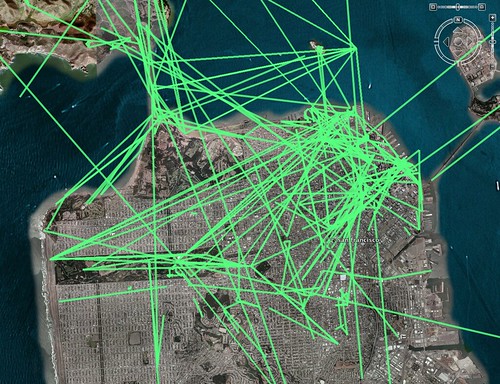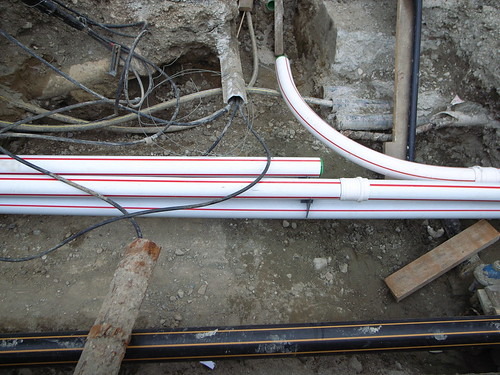My notes from a talk I attend at the "Digitality and space" seminar CHOROS lab: "code/space" by Rob Kitchin (National University of Ireland, Maynooth).
The presenter started by this quote from Thrift and French: "[M]ore and more ... the spaces of everyday life come loaded up with software" (2002, p.309). The point of this talk was to show how, over time, the spaces of everyday life have become increasingly reliant on software (space is being virtualized, in the sense of Manuel Castells). And so much so that many spaces and the life they support would malfunction. For instance, an airport cannot work without "code"/software.
He then described the forms of code embedded in everyday life in 4 ways:
- coded objects: non-networked objects that use code to function or permanently store digital data that cannot be accessed without software: "internet of things", "blogjects" as described by Julian Bleecker (automated, automatic, autonomous)
- coded infrastructures: networks that link coded objects and infrastructure that is monitored and regulated, either fully or in part, by code: computing networks, communication and entertainment networks, transport and logistics networks, financial networks...
- coded processes: the transaction and flow of digital data across coded infrastructure. Important when they access, update and monitor relational databases that hold individual and institutional data... can be accessed at a distance and used to verify, monitor and regulate user access: bank accounts, crime, utility usage, mortgage...
- coded assemblages: they are where several different coded infrastructures converge, working together—either in
nested systems or in parallel, some using coded processes, others not—and, over time, become integral to one another in producing particular environments, such as office complexes, transport systems, and shopping centers.
Some examples that has been described to exemplify this:
- Home: task and routines of everyday home life are augmented, mediated and regulated through computers
- Buildings: parts of infrastructures are mediated by software such as lifts and doors... building management systems ("you sometimes need to reboot the lift, if the software fails, the lift fails, it's not longer a physical artifact")
- Utility infrastructure (water, electricity...): might appear dumb but are all controlled and managed using software
- Road infrastructure: traditional regulatory technologies (conventional signs, traffic lights) are complemented with "smart media" (automatic altering of traffic light sequences, updating of road speed signs, automatic logging of vehicular congestion, variable toll charges, cameras designs to discipline behavior...)... aim to monitor ad regulate the transport system in real-time. See for instance GCM travel
- mobile telematics infrastructures: cars and the highway communicate with each other to adapt traffic management. State and emergency vehicles will generate data with respect to other traffic (vehicle speed, location, heading), weather (wiper operation, lights on/off) and transmit this information to a central control... analysis of the generated data is then used to deploy road and maintenance crews and communicated to other drivers: highways message signs, 511.
- rail: various rail systems are reliant on code for its day-to-day operation
- airport: ticket purchase online (even there), check-in is verified by your code, baggage is route through barcode and tags... the plane itself is a fully software entity...
- communication: most communication takes place via coded infrastructures, facilitating time space compression, convergence by allowing instantaneous communication across distrance, reconfigure where people live.
- work places
- retail and consumption: intertwining of the coded assemblages of financial services, logistics and shop leisure facilities
(More about it in the following paper: Code and the Transduction of Space by Martin Dodge and Rob Kitchin)
So, what's the difference? about software and everyday spatialities:
In thinking through the work that software does in the world we have found it useful to rethink of the concept of space. So Kitchin stepped back and described the evolution in the space/place research. There has been an evolution: Involves a shift from ontology (what something is) to ontogenesis (how things become). From space to spacing. This is part of a longer process of conceptualising space: implicit then absolute then cognitive then relative (materialist, metaphorical: virtual) and nowawdays performative. Spacing is not ontologically secure, space is always the process of becoming, it is always a process of taking place. Space in these terms is a practice; a doing; and event; a becoming - a material and social reality forever (re)created in the moment. Space gains its form, function and meaning through practices and it ceaselessly emerges.
How does it emerge? through what Kitchin described as "transduction of space" = technicity is the unfolding or evolutive power of technologies to make things happen: agency (Mackenzie, 2003). Software possesses technicity (a cell phone can link people across spaces). Software helps solving problems or even automate the solving of a problem.
Space is constantly being bought into being "as an incomplete solution to a relational problem". Where the relational problem is an encounter between people and environment and the solution, to a greater or lesser extent is software. Relational problem include undertaking domestic tasks, traveling between locations, conducting work, practicing consumption.
The 4 objects described at the beginning of the talk (coded objects, infrastructures, processes and assemblages) beckons new spatial formations into existence. Kitchin differentiated two notions:
- "Code/space" are spaces dependent on code to function - wherein the materiality of everyday life and its attendant virtual coding are mutually constituted. The relationship between code and space is dyadic (without code, the space would no be transduced as intended: hence "code/space" rather than "code space"). Old non software means of doing things have sometimes disappeared.
- Coded space is a transduction hat is mediated by code, but whose relationship is not dyadic. Software mediates the solution to a problem, but it is not the only solution
Code/space are non-deterministic and non-universal. How code/space operates and is experienced is open to rupture: it's an embodied process, through the performances and interactions of the people within the space (between people, and between people and code). It should be seen as a complex system in state of becoming, with emergent properties, it then needs to be analyzed as complex systems with emergent properties. Kitchin is currently exploring this issue in airport.
The regulatory environment of code/space is increasingly that of automated management (in the sense that it is enacted by technologies that are automatic/autonoumous in nature). Rather than an external surveillance system working to self-discipline, capture is an wholly internalized feature of an activity (Example: buying a ticket is the way you're surveyed: it's internal to the system). There is a move from oligopticon to panopticon or surveillance versus capture.
Conclusion: software will increasingly reshape activities and how we perform them + the material functioning. Code makes a difference in part because it alternatively modulates space. We need to develop appropriate tools for conceptualising the relationships between software and space.
Why do I blog this? This way of establishing a new typology of relationships between space and software (technology) is very intriguing. There seems indeed to be a need to address the topic of 1st life/2nd life connections. Some personal remarks:
- Good to see that the blogject meme also spread enough so that geographers start to feel this will change the way we inhabit space.
- I am not that familiar with geographers work but it seems that there is a good overlap with stuff I am interested in (studying how technology reshape spatial practices). Some work to use in further projects about spatiality!
- From a cognitive sciences standpoint, the metaphors used by this field seem to be very well in tune with situated action and ethnomethodological way of describing human action (this is not apparent in my notes, it was rather due to the examples the speaker employed).





 (Picture:
(Picture: 




